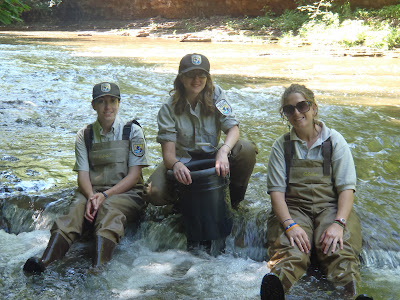Nestled between Lake Ontario and Lake Erie in western New York, the Service's Lower Great Lakes Fish and Wildlife Conservation Office is located in an incredibly unique area. Part of the reason this area is so interesting is the high number of streams with freshwater mussels.
 |
| A native freshwater mussel found in the stream during a road-crossing survey. Credit: USFWS |
Freshwater mussel populations are in decline all over the country. Pollution and habitat loss are two of the leading causes of the population decline. As the human population grows and cities spread out, more roads are built, many of which cross streams. When those road crossings are installed correctly, they cause no problems.
However, due to budget constraints and lack of training for the installers, many crossings are under-sized or incorrectly installed. This causes a major problem for fish and other critters that live in the stream. The road crossing becomes a barrier to fish migration, as well as the migration of other species, including freshwater mussels.
 |
| This culvert is a complete barrier to fish passage. Credit: USFWS |
To the untrained eye, mussels might just look like rocks on the bottom of the stream, but when you know a little bit about their lives and what they do, they are incredible! Freshwater mussels do some of the coolest things in order to reproduce.
Some of them actually make their mantle (the fleshy lining inside their shell) look like a small fish to lure larger fish to them. Why do they do that? So that the little baby mussels, known as glochidia, can attach to the host fish to grow. As the mussels grow, the host fish carries them to new parts of the stream where they drop off and establish new populations.
Of course, if there is a barrier to fish migration, the baby mussels don’t make it very far. And that’s if they get anywhere at all. The barrier might mean that there are no host fish in certain sections of the stream. If there aren’t any host fish, the baby mussels don’t survive.
For the past two years, fish biologists Raymond Li, Marie Schrecengost, and Chris Castiglione and several fish technicians (Karolyn Lock, Jerry Krajna, Elizabeth Migliore, and Tracy Wilcox) at the Lower Great Lakes Fish and Wildlife Conservation Office have been working with Amy Mahar and Jenny Landry from the New York State Department of Environmental Conservation to find the streams in the Lake Ontario watershed where freshwater mussels are present and then find the barriers on those streams.
 |
| Elizabeth Migliore, Karolyn Lock and Tracy Wilcox take a break from mussel hunting in the stream. Credit: USFWS |
During the course of this work, the group found 22 different types of freshwater mussels and surveyed 29 streams for road crossing barriers.
A little more than 35 percent of the road crossings caused some kind of barrier for fish. The surveys have resulted in more than a thousand points on a map, but we will have the locations prioritized soon.
Then, we will be able to start fixing the road crossings that create barriers.
The Service and community partners opened more than 2,180 miles of streams to native fish and mussel populations in 2011 by removing or bypassing 158 dams, culverts and other structures. Read more in the 2011 National Fish Passage Program annual report.
More resources:
Submitted by Marie Schrecengost, a fisheries biologist at the Lower Great Lakes Fish and Wildlife Conservation Office.
No comments:
Post a Comment